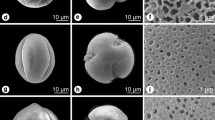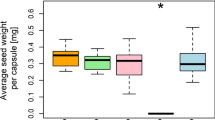Key message
We found a correlation between large pollens and selfing and between psilate pollen walls and cleistogamy.
Abstract
Flowering plants display extraordinary diversity in pollen morphology, yet the functional significance of this variation is not well understood. Zygophylloideae is a lineage characterized by high diversity of breeding systems, ranging from obligate selfing to facultative selfing and further to facultative outcrossing. This group is particularly suitable for testing hypotheses about the influence of breeding system on pollen morphology. We studied pollen morphology in 20 species of Zygophylloideae and one species of Tribuloideae as an outgroup. A phylogeny of Zygophylloideae was created based on available DNA sequences and used to trace the evolution of pollen characters. We performed a phylogenetic analysis of correlated evolution between breeding system and several pollen characters. Three types of pollen morphology were found in the studied species. Tricolporate pollen with a small apocolpium, microreticulate ornamentation and medium size was determined as the ancestral state in Zygophylloideae. The correlation analysis indicated an association between large pollens and selfing and between psilate pollen wall and cleistogamy. We hypothesize that large size of pollen in selfing species is mainly associated with the low number of produced pollen indicating a trade-off between pollen size and number. The independence from pollen vector in cleistogamous flowers accounts for the evolution of smooth pollen walls in these species.




Similar content being viewed by others
References
Abdel Khalik KN (2012) A numerical taxonomic study of the family Zygophyllaceae from Egypt. Acta Bot Bras 26:165–180
APG IV (2016) An update of the Angiosperm Phylogeny Group classification for the orders and families of lowering plants: APG IV. Bot J Linn Soc 181:1–20
Banks H, Rudall PJ (2016) Pollen structure and function in caesalpinioid legumes. Am J Bot 103:423–436
Beier BA, Chase MW, Thulin M (2003) Phylogenetic relationships and taxonomy of subfamily Zygophylloideae (Zygophyllaceae) based on molecular and morphological data. Plant Syst Evol 240:11–39
Castresana J (2000) Selection of conserved blocks from multiple alignments for their use in phylogenetic analysis. Mol Biol Evol 17:540–552
Cruden RW (2000) Pollen grains: why so many? Plant Syst Evol 222:143–165
Cruzan MB (1990) Variation in pollen size, fertilization ability, and postfertilization siring ability in Erythronium grandiflorum. Evolution 44:843–856
Ejsmond MJ, Wrońska-Pilarek D, Ejsmond A, Dragosz-Kluska D, Karpińska-Kołaczek M, Kołaczek P, Kozłowski J (2011) Does climate affect pollen morphology? Optimal size and shape of pollen grains under various desiccation intensity. Ecosphere 2:1–15
Ejsmond MJ, Ejsmond A, Banasiak Ł, Karpińska-Kołaczek M, Jan Kozłowski J, Kołaczek P (2015) Large pollen at high temperature: an adaptation to increased competition on the stigma? Plant Ecol 216:1407–1417
Erdtman G (1969) Handbook of palynology. Hafner, New York
Ferguson IK, Skvarla JJ (1982) Pollen morphology in relation to pollinators in Papilionoideae (Leguminosae). Bot J Linn Soc 84:183–193
Gess SK, Gess FW (2010) Pollen wasps and flowers in southern Africa. In: SANBI Biodiversity Series, vol. 18. South African National Biodiversity Institute, Pretoria
Gess SK, Gess FW (2014) Wasps and bees in southern Africa. In: SANBI Biodiversity Series, vol. 24. South African National Biodiversity Institute, Pretoria
Hesse M, Halbritter H, Zetter R, Weber M, Buchner R, Frosch-Radivo A, Ulrich S (2009) Pollen terminology—an illustrated handbook. Springer, New York
Kataoka H, Miyoshi N (2002) Pollen morphology of Trapella sinensis Oliver (Trapellaceae). Jpn J Palynol 48:19–23
Katifori E, Alben S, Cerda E, Nelson DR, Dumais J (2010) Foldable structures and the natural design of pollen grains. Proc Natl Acad Sci 107:7635–7639
Kumar S, Stecher G, Tamura K (2016) MEGA7: molecular evolutionary genetics analysis version 7.0 for bigger datasets. Mol Biol Evol 33:1870–1874
Lauterbach M, van der Merwe PW, Keßler L, Pirie MD, Bellstedt DU, Kadereit G (2016) Evolution of leaf anatomy in arid environments—a case study in southern African Tetraena and Roepera (Zygophyllaceae). Mol Phylogenetics Evol 97:129–144
Lewis PO (2001) A likelihood approach to estimating phylogeny from discrete morphological character data. Syst Biol 50:913–925
Linder HP (1998) Morphology and the evolution of wind pollination. In: Owens SJ, Rudall PJ (eds) Reproductive biology. Royal Botanic Gardens, Kew, pp 123–135
Maddison WP, Maddison DR (2015) Mesquite: a modular system for evolutionary analysis. Version 3.04. http://mesquiteproject.org. Accessed Nov 2018
Manicacci D, Barrett SCH (1995) Stamen elongation, pollen size, and siring ability in tristylous Eichhornia paniculata (Pontederiaceae). Am J Bot 82:1381–1389
Matamoro-Vidal A, Raquin C, Brisset F, Colas H, Izac B, Albert B, Gouyon PH (2016) Links between morphology and function of the pollen wall: an experimental approach. Bot J Linn Soc 180:478–490
McCallum B, Chang SM (2016) Pollen competition in style: effects of pollen size on siring success in the hermaphroditic common morning glory, Ipomoea purpurea. Am J Bot 103:460–470
Naghiloo S, Bellstedt DU, Claßen-Bockhoff R (2018) Nectar protection in arid adapted flowers of Zygophyllaceae-Zygophylloideae. PPEES 34:37–50
Naghiloo S, Bellstedt DU, Claßen-Bockhoff R (2019) The plasticity of breeding system in arid-adapted Zygophylloideae. J Arid Environ 162:1–9
Osborn JM, Taylor TN, Schneider EL (1991) Pollen morphology and ultrastructure of the Cabombaceae: correlations with pollination biology. Am J Bot 78:1367–1378
Pagel MD (1994) Detecting correlated evolution on phylogenies: a general method for the comparative analysis of discrete characters. Proc R Soc Lond [Biol] 255:37–45
Perveen A, Qaizer M (2006) Pollen flora of Pakistan. XLIX Zygophyllaceaee. Pak J Bot 38:225–232
Sannier J, Baker WJ, Anstett MC, Nadot S (2009) A comparative analysis of pollinator type and pollen ornamentation in the Araceae and the Arecaceae, two unrelated families of the monocots. BMC Res Notes 2:145
Sheahan MC (2007) Zygophyllaceae. In: Kubitzki K (ed) The families and genera of vascular plants, vol IX. Springer, Berlin, pp 488–500
Sheahan MC, Chase MW (2000) Phylogenetic relationships within Zygophyllaceae based on DNA sequences of three plastid regions, with special emphasis on Zygophylloideae. Syst Bot 25:371–384
Silvestro D, Michalak I (2012) raxmlGUI: a graphical front-end for RAxML. Org Divers Evol 12:335–337
Stroo A (2000) Pollen morphological evolution in bat pollinated plants. Plant Syst Evol 222:225–242
Tao ZB, Wortley AH, Lu L, Li DZ, Wang H, Blackmore S (2018) Evolution of angiosperm pollen. 6. The Celastrales, Oxalidales, and Malpighiales (Com) Clade and Zygophyllales. Ann Mo Bot Gard 103:393–442
Tedder A, Carleial S, Gołębiewska M, Kappel C, Shimizu KK, Stift M (2015) Evolution of the selfing syndrome in Arabis alpina (Brassicaceae). PLoS ONE 10(6):e0126618
Van der Merwe PDW (2015) Systematic and genomic studies in the plant genus Zygophyllum. M.Sc. thesis, University of Stellenbosch, RSA
Vonhof MJ, Harder LD (1995) Size-number trade-offs and pollen production by Papilionaceous legumes. Am J Bot 82:138–230
Whitehead DR (1969) Wind pollination in the angiosperms; evolutionary and environmental considerations. Evolution 23:28–35
Acknowledgements
The work was financially supported by a fellowship given by the Alexander von Humboldt Foundation to the first author. We thank Prof. Dirk U. Bellstedt (University of Stellenbosch, Stellenbosch, South Africa) for assisting in sample collection and Saeed Javadi Anaghizi (Central Laboratory of the Shahid Beheshti University, Tehran, Iran) for providing SEM photographs.
Author information
Authors and Affiliations
Corresponding author
Additional information
Communicated by Joseph Williams.
Publisher's Note
Springer Nature remains neutral with regard to jurisdictional claims in published maps and institutional affiliations.
Rights and permissions
About this article
Cite this article
Naghiloo, S., Nikzat Siahkolaee, S. Does breeding system affect pollen morphology? A case study in Zygophylloideae (Zygophyllaceae). Plant Reprod 32, 381–390 (2019). https://doi.org/10.1007/s00497-019-00379-4
Received:
Accepted:
Published:
Issue Date:
DOI: https://doi.org/10.1007/s00497-019-00379-4




